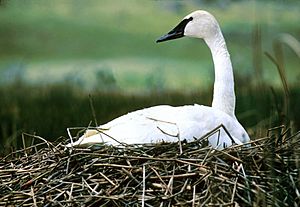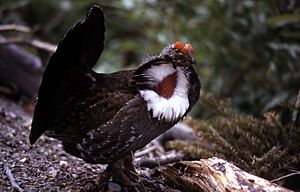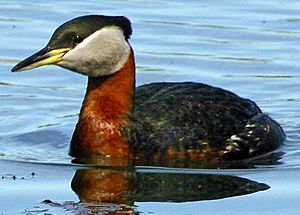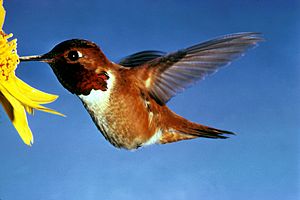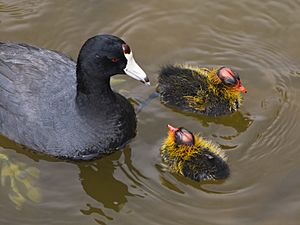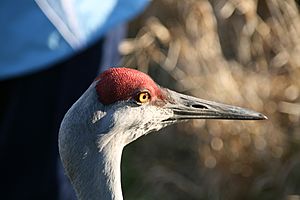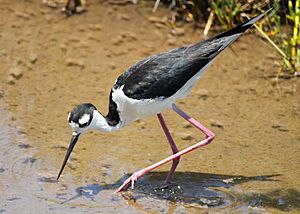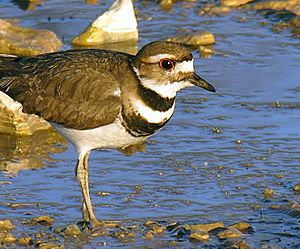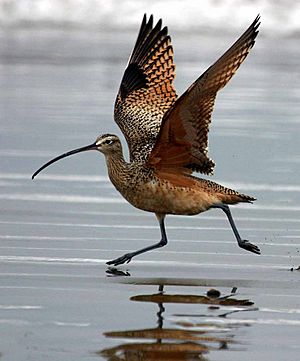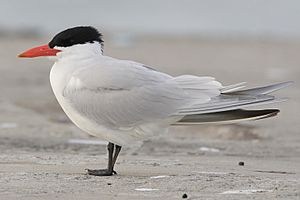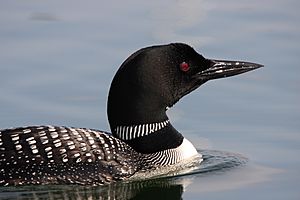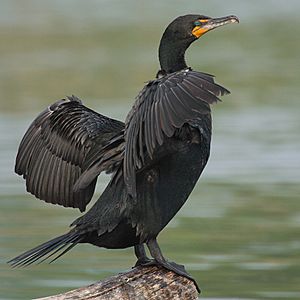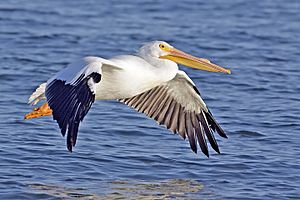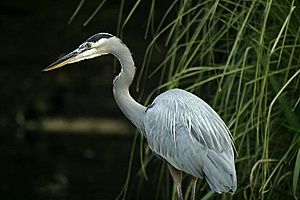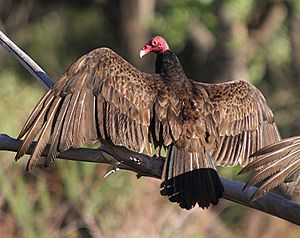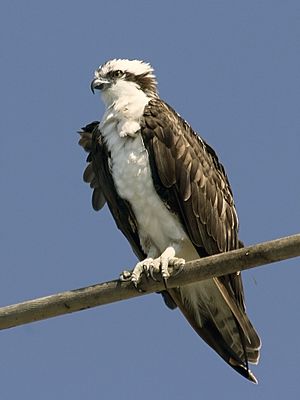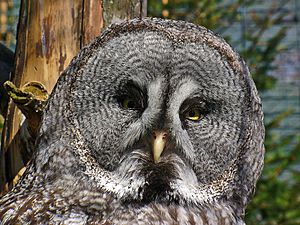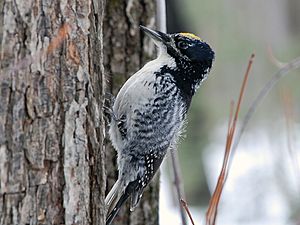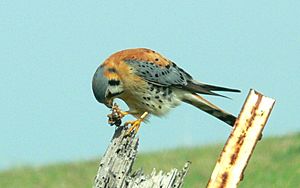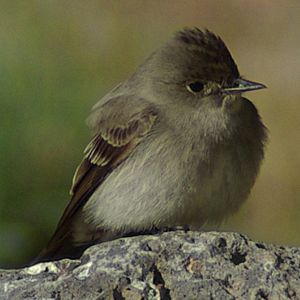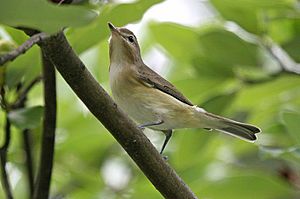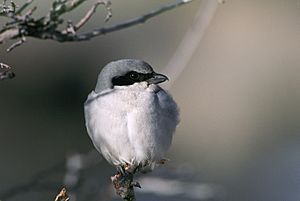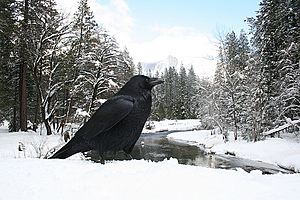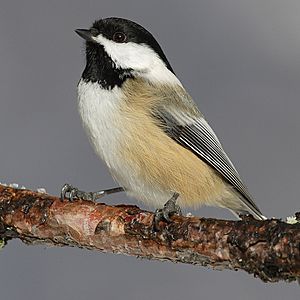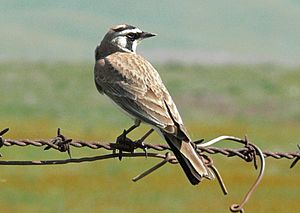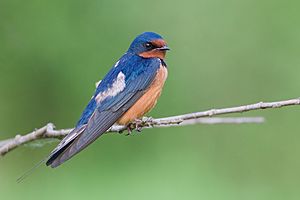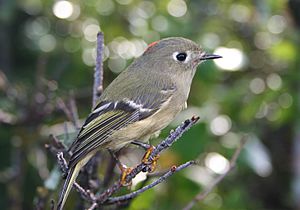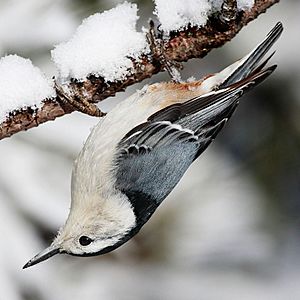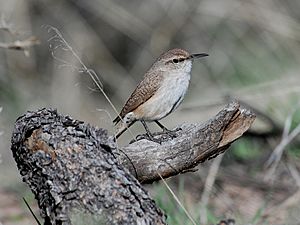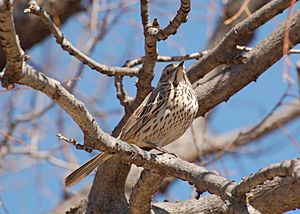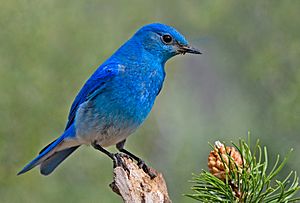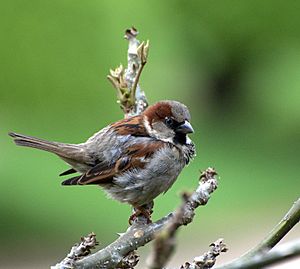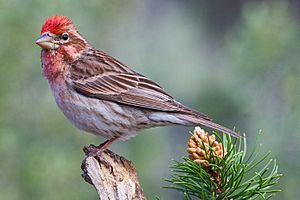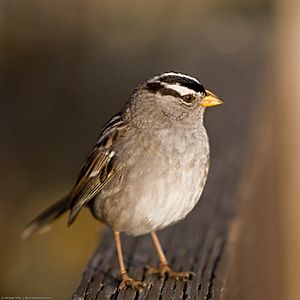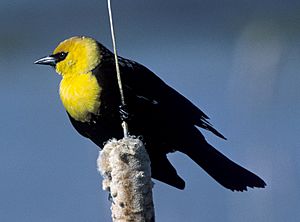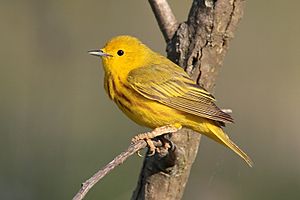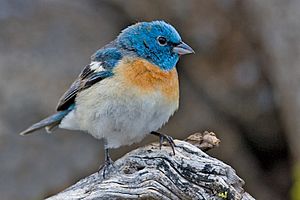List of birds of Yellowstone National Park facts for kids
Yellowstone National Park, mostly located in Wyoming but also stretching into Idaho and Montana, is home to many amazing birds! This list tells you about the 284 different kinds of birds that have been seen here. It's based on a list from the National Park Service (NPS) from June 2021.
Birds are listed by their scientific groups, following the Check-list of North and Middle American Birds. The names of the bird families come from the Clements taxonomy.
Most birds on this list live in Yellowstone regularly. Some stay all year, some visit in summer or winter, and others just pass through. The letters next to each bird's name tell you how common they are:
- B = Breeding: This means they have definitely had babies (eggs or young) in Yellowstone. (155 species)
- b = Unconfirmed breeding: We think they might be breeding, but it's not fully proven yet. (4 species)
- U = Uncommon: You can find a few of these birds, but you might have to look carefully. (64 species)
- R = Rare: These birds are seen only in very small numbers each year, or in special places. They are hard to find! (76 species)
- O = Occasional: These birds show up some years, but not every year. (4 species)
- V = Vagrant: These are "accidental" visitors, meaning they are rarely seen and usually off their normal path. (66 species)
- I = Introduced: These birds were brought to North America by people. (7 species)
Contents
- Ducks, Geese, and Swans
- Pheasants, Grouse, and Allies
- Grebes
- Pigeons and Doves
- Cuckoos
- Nightjars and Allies
- Swifts
- Hummingbirds
- Rails, Gallinules, and Coots
- Cranes
- Stilts and Avocets
- Plovers and Lapwings
- Sandpipers and Allies
- Gulls, Terns, and Skimmers
- Loons
- Cormorants and Shags
- Pelicans
- Herons, Egrets, and Bitterns
- Ibises and Spoonbills
- New World Vultures
- Osprey
- Hawks, Eagles, and Kites
- Owls
- Kingfishers
- Woodpeckers
- Falcons and Caracaras
- Tyrant Flycatchers
- Vireos and Allies
- Shrikes
- Crows, Jays, and Magpies
- Tits, Chickadees, and Titmice
- Larks
- Swallows
- Kinglets
- Waxwings
- Nuthatches
- Treecreepers
- Gnatcatchers
- Wrens
- Mockingbirds and Thrashers
- Starlings
- Dippers
- Thrushes and Allies
- Old World Sparrows
- Wagtails and Pipits
- Finches and Allies
- Longspurs and Snow Buntings
- New World Sparrows
- Yellow-breasted Chat
- Troupials and Allies
- New World Warblers
- Cardinals and Allies
- Images for kids
- See also
Ducks, Geese, and Swans
Order: Anseriformes Family: Anatidae
This family includes ducks, geese, and swans. These birds love water! They have webbed feet for swimming and special feathers that shed water easily. Thirty-four different kinds of these birds have been seen in Yellowstone.
| Common name | Binomial | Status |
|---|---|---|
| Snow goose | Anser caerulescens | R |
| Ross's goose | Anser rossii | R |
| Greater white-fronted goose | Anser albifrons | V |
| Cackling goose | Branta hutchinsii | V |
| Canada goose | Branta canadensis | B |
| Trumpeter swan | Cygnus buccinator | B |
| Tundra swan | Cygnus columbianus | U |
| Whooper swan | Cygnus cygnus | V |
| Wood duck | Aix sponsa | R |
| Blue-winged teal | Spatula discors | B U |
| Cinnamon teal | Spatula cyanoptera | B |
| Northern shoveler | Spatula clypeata | B |
| Gadwall | Mareca strepera | B |
| Eurasian wigeon | Mareca penelope | V |
| American wigeon | Mareca americana | B |
| Mallard | Anas platyrhynchos | B |
| Northern pintail | Anas acuta | B |
| Green-winged teal | Anas crecca | B |
| Canvasback | Aythya valisineria | B U |
| Redhead | Aythya americana | B U |
| Ring-necked duck | Aythya collaris | B |
| Greater scaup | Aythya marila | R |
| Lesser scaup | Aythya affinis | B |
| Harlequin duck | Histrionicus histrionicus | B U |
| Surf scoter | Melanitta perspicillata | V |
| White-winged scoter | Melanitta deglandi | V |
| Long-tailed duck | Clangula hyemalis | V |
| Bufflehead | Bucephala albeola | B |
| Common goldeneye | Bucephala clangula | |
| Barrow's goldeneye | Bucephala islandica | B |
| Hooded merganser | Lophodytes cucullatus | B R |
| Common merganser | Mergus merganser | B |
| Red-breasted merganser | Mergus serrator | U |
| Ruddy duck | Oxyura jamaicensis | B |
Pheasants, Grouse, and Allies
Order: Galliformes Family: Phasianidae
This family includes pheasants and their relatives. These birds live on land. They are usually plump with broad, short wings. Many are hunted for sport or raised for food. Eight species have been seen in Yellowstone.
| Common name | Binomial | Status |
|---|---|---|
| Wild turkey | Meleagris gallopavo | V |
| Ruffed grouse | Bonasa umbellus | B |
| Dusky grouse | Dendragapus obscurus | B |
| Gray partridge | Perdix perdix | I V |
| Chukar | Alectoris chukar | V |
Grebes
Order: Podicipediformes Family: Podicipedidae
Grebes are diving birds that live in freshwater. They have lobed toes, making them excellent swimmers. However, their feet are set far back on their bodies, so they are clumsy on land. Six species have been recorded in Yellowstone.
| Common name | Binomial | Status |
|---|---|---|
| Pied-billed grebe | Podilymbus podiceps | B |
| Horned grebe | Podiceps auritus | B R |
| Red-necked grebe | Podiceps grisegena | B R |
| Eared grebe | Podiceps nigricollis | B U |
| Western grebe | Aechmophorus occidentalis | b R |
| Clark's grebe | Aechmophorus clarkii | R |
Pigeons and Doves
Order: Columbiformes Family: Columbidae
Pigeons and doves are birds with sturdy bodies, short necks, and thin bills. Four species have been seen in Yellowstone.
| Common name | Binomial | Status |
|---|---|---|
| Rock pigeon | Columba livia | I B U |
| Band-tailed pigeon | Patagioenas fasciata | V |
| Eurasian collared-dove | Streptopelia decaocto | I R |
| Mourning dove | Zenaida macroura | B R |
Cuckoos
Order: Cuculiformes Family: Cuculidae
This family includes cuckoos and roadrunners. These birds have slender bodies, long tails, and strong legs. Only one species has been recorded in Yellowstone.
| Common name | Binomial | Status |
|---|---|---|
| Black-billed cuckoo | Coccyzus erythropthalmus | V |
Nightjars and Allies
Order: Caprimulgiformes Family: Caprimulgidae
Nightjars are medium-sized birds that are active at night. They usually nest on the ground. They have long wings and very short bills. Their soft feathers help them blend in with tree bark or leaves. Two species have been seen in Yellowstone.
| Common name | Binomial | Status |
|---|---|---|
| Common nighthawk | Chordeiles minor | B |
Swifts
Order: Apodiformes Family: Apodidae
Swifts are small birds that spend most of their lives flying. They have very short legs and almost never land on the ground. Many swifts have long, swept-back wings. One species has been recorded in Yellowstone.
| Common name | Binomial | Status |
|---|---|---|
| White-throated swift | Aeronautes saxatalis | B U |
Hummingbirds
Order: Apodiformes Family: Trochilidae
Hummingbirds are tiny birds famous for hovering in the air by flapping their wings super fast. They are the only birds that can fly backward! Four species have been seen in Yellowstone.
| Common name | Binomial | Status |
|---|---|---|
| Calliope hummingbird | Selasphorus calliope | B R |
| Rufous hummingbird | Selasphorus rufus | B R |
| Broad-tailed hummingbird | Selasphorus platycercus | B R |
Rails, Gallinules, and Coots
Order: Gruiformes Family: Rallidae
This family includes rails, crakes, coots, and gallinules. These birds often live in thick plants near lakes or swamps. They are usually shy and hard to spot. Most have strong legs and long toes, good for walking on soft ground. Five species have been seen in Yellowstone.
| Common name | Binomial | Status |
|---|---|---|
| Virginia rail | Rallus limicola | B R |
| Sora | Porzana carolina | B |
| American coot | Fulica americana | B |
| Yellow rail | Coturnicops noveboracensis | V |
Cranes
Order: Gruiformes Family: Gruidae
Cranes are large birds with long legs and necks. Unlike herons, cranes fly with their necks stretched out. Many cranes have loud calls and perform fancy "dances" when looking for a mate. Two species have been recorded in Yellowstone.
| Common name | Binomial | Status |
|---|---|---|
| Sandhill crane | Antigone canadensis | B |
| Whooping crane | Grus americana | V |
Stilts and Avocets
Order: Charadriiformes Family: Recurvirostridae
This family includes avocets and stilts. They are large wading birds. Avocets have long legs and bills that curve upwards. Stilts have extremely long legs and thin, straight bills. Two species have been seen in Yellowstone.
| Common name | Binomial | Status |
|---|---|---|
| Black-necked stilt | Himantopus mexicanus | R |
| American avocet | Recurvirostra americana | R |
Plovers and Lapwings
Order: Charadriiformes Family: Charadriidae
This family includes plovers and lapwings. They are small to medium-sized birds with compact bodies and short, thick necks. They live in open areas, often near water. Four species have been recorded in Yellowstone.
| Common name | Binomial | Status |
|---|---|---|
| Black-bellied plover | Pluvialis squatarola | R |
| Killdeer | Charadrius vociferus | B |
| Semipalmated plover | Charadrius semipalmatus | R |
Sandpipers and Allies
Order: Charadriiformes Family: Scolopacidae
This is a large family of shorebirds, including sandpipers, curlews, and snipes. Most of these birds eat small bugs they find in mud or soil. Different bill and leg lengths allow many species to feed in the same areas without fighting for food. Twenty-three species have been seen in Yellowstone.
| Common name | Binomial | Status |
|---|---|---|
| Upland sandpiper | Bartramia longicauda | R |
| Long-billed curlew | Numenius americanus | B R |
| Marbled godwit | Limosa fedoa | R |
| Ruddy turnstone | Arenaria interpres | R |
| Sanderling | Calidris alba | R |
| Baird's sandpiper | Calidris bairdii | U |
| Least sandpiper | Calidris minutilla | R |
| White-rumped sandpiper | Calidris fuscicollis | R |
| Pectoral sandpiper | Calidris melanotos | R |
| Semipalmated sandpiper | Calidris pusilla | R |
| Western sandpiper | Calidris mauri | R |
| Short-billed dowitcher | Limnodromus griseus | R |
| Long-billed dowitcher | Limnodromus scolopaceus | U |
| Wilson's snipe | Gallinago delicata | B |
| Spotted sandpiper | Actitis macularia | B |
| Solitary sandpiper | Tringa solitaria | R |
| Lesser yellowlegs | Tringa flavipes | R |
| Willet | Tringa semipalmata | U |
| Greater yellowlegs | Tringa melanoleuca | U |
| Wilson's phalarope | Phalaropus tricolor | B U |
| Red-necked phalarope | Phalaropus lobatus | R |
Gulls, Terns, and Skimmers
Order: Charadriiformes Family: Laridae
This family includes gulls and terns. They are medium to large seabirds, often gray or white with black marks. They have strong bills and webbed feet. Twelve species have been recorded in Yellowstone.
| Common name | Binomial | Status |
|---|---|---|
| Sabine's gull | Xema sabini | V |
| Bonaparte's gull | Larus philadelphia | R |
| Franklin's gull | Larus pipixcan | R |
| Short-billed gull | Larus brachyrhynchus | V |
| Ring-billed gull | Larus delawarensis | |
| California gull | Larus californicus | B |
| Herring gull | Larus argentatus | R |
| Caspian tern | Hydroprogne caspia | B R |
| Black tern | Chlidonias niger | V |
| Common tern | Sterna hirundo | R |
| Arctic tern | Sterna paradisaea | V |
| Forster's tern | Sterna forsteri | B R |
Loons
Order: Gaviiformes Family: Gaviidae
Loons are water birds, about the size of a large duck. They are mostly gray or black with pointed bills. Loons swim and fly well, but they are very awkward on land because their legs are at the back of their bodies. Two species have been seen in Yellowstone.
| Common name | Binomial | Status |
|---|---|---|
| Pacific loon | Gavia pacifica | V |
| Common loon | Gavia immer | B U |
Cormorants and Shags
Order: Suliformes Family: Phalacrocoracidae
Cormorants are medium to large water birds, usually dark-colored. They have long, thin, hooked bills and webbed feet. One species has been recorded in Yellowstone.
| Common name | Binomial | Status |
|---|---|---|
| Double-crested cormorant | Nannopterum auritum | B U |
Pelicans
Order: Pelecaniformes Family: Pelecanidae
Pelicans are very large water birds with a special pouch under their beak for catching fish. Like other birds in their group, they have four webbed toes. One species has been seen in Yellowstone.
| Common name | Binomial | Status |
|---|---|---|
| American white pelican | Pelecanus erythrorhynchos | B |
Herons, Egrets, and Bitterns
Order: Pelecaniformes Family: Ardeidae
This family includes herons, egrets, and bitterns. Herons and egrets are medium to large wading birds with long necks and legs. Bitterns are usually shorter-necked and more secretive. These birds fly with their necks pulled back. Eight species have been recorded in Yellowstone.
| Common name | Binomial | Status |
|---|---|---|
| American bittern | Botaurus lentiginosus | V |
| Great blue heron | Ardea herodias | B |
| Great egret | Ardea alba | V |
| Snowy egret | Egretta thula | V |
| Tricolored heron | Egretta tricolor | V |
| Cattle egret | Bubulcus ibis | V |
| Green heron | Butorides virescens | V |
| Black-crowned night-heron | Nycticorax nycticorax | R |
Ibises and Spoonbills
Order: Pelecaniformes Family: Threskiornithidae
This family includes ibises and spoonbills. They have long, wide wings and long necks and legs. Ibises have bills that curve downwards, while spoonbills have flat, spoon-shaped bills. One species has been seen in Yellowstone.
| Common name | Binomial | Status |
|---|---|---|
| White-faced ibis | Plegadis chihi | R |
New World Vultures
Order: Cathartiformes Family: Cathartidae
New World vultures are scavengers, meaning they eat dead animals. They find food using their excellent sense of smell. One species has been recorded in Yellowstone.
| Common name | Binomial | Status |
|---|---|---|
| Turkey vulture | Cathartes aura | U |
Osprey
Order: Accipitriformes Family: Pandionidae
The Osprey is a fish-eating bird of prey. It has a large, strong, hooked beak, powerful talons, and sharp eyesight. It's the only bird in its family.
| Common name | Binomial | Status |
|---|---|---|
| Osprey | Pandion haliaetus | B |
Hawks, Eagles, and Kites
Order: Accipitriformes Family: Accipitridae
This family includes hawks, eagles, and kites. These are birds of prey with very large, strong, hooked beaks for tearing meat. They also have powerful legs, sharp talons, and amazing eyesight. Twelve species have been recorded in Yellowstone.
| Common name | Binomial | Status |
|---|---|---|
| Golden eagle | Aquila chrysaetos | B U |
| Northern harrier | Circus cyaneus | B U |
| Sharp-shinned hawk | Accipiter striatus | B U |
| Cooper's hawk | Accipiter cooperii | B U |
| Northern goshawk | Accipiter gentilis | B U |
| Bald eagle | Haliaeetus leucocephalus | B |
| Red-shouldered hawk | Buteo lineatus | V |
| Broad-winged hawk | Buteo platypterus | R |
| Swainson's hawk | Buteo swainsoni | B |
| Red-tailed hawk | Buteo jamaicensis | B |
| Rough-legged hawk | Buteo lagopus | U |
| Ferruginous hawk | Buteo regalis | U |
Owls
Order: Strigiformes Family: Strigidae
Owls are usually solitary birds of prey that are active at night. They have large eyes that face forward, good hearing, a hooked beak, and a circle of feathers around each eye. Eleven species have been seen in Yellowstone.
| Common name | Binomial | Status |
|---|---|---|
| Flammulated owl | Psiloscops flammeolus | V |
| Western screech-owl | Megascops kennicottii | V |
| Great horned owl | Bubo virginianus | B |
| Snowy owl | Bubo scandiacus | V |
| Northern pygmy-owl | Glaucidium gnoma | B R |
| Burrowing owl | Athene cunicularia | V |
| Great gray owl | Strix nebulosa | B U |
| Long-eared owl | Asio otus | B R |
| Short-eared owl | Asio flammeus | B R |
| Boreal owl | Aegolius funereus | B R |
| Northern saw-whet owl | Aegolius acadicus | B R |
Kingfishers
Order: Coraciiformes Family: Alcedinidae
Kingfishers are medium-sized birds with large heads, long pointed bills, short legs, and short tails. One species has been recorded in Yellowstone.
| Common name | Binomial | Status |
|---|---|---|
| Belted kingfisher | Megaceryle alcyon | B U |
Woodpeckers
Order: Piciformes Family: Picidae
Woodpeckers are small to medium-sized birds with chisel-like beaks. They have stiff tails and long tongues to catch insects. Many woodpeckers tap loudly on tree trunks. Ten species have been seen in Yellowstone.
| Common name | Binomial | Status |
|---|---|---|
| Lewis's woodpecker | Melanerpes lewis | B R |
| Williamson's sapsucker | Sphyrapicus thyroideus | B U |
| Red-naped sapsucker | Sphyrapicus nuchalis | B U |
| American three-toed woodpecker | Picoides dorsalis | B U |
| Black-backed woodpecker | Picoides arcticus | B R |
| Downy woodpecker | Dryobates pubescens | B U |
| Hairy woodpecker | Dryobates villosus | B |
| Northern flicker | Colaptes auratus | B |
| Pileated woodpecker | Dryocopus pileatus | B R |
Falcons and Caracaras
Order: Falconiformes Family: Falconidae
This family includes falcons and caracaras. These birds of prey kill their prey with their beaks, unlike hawks and eagles which use their talons. Five species have been recorded in Yellowstone.
| Common name | Binomial | Status |
|---|---|---|
| Crested caracara | Caracara plancus | V |
| American kestrel | Falco sparverius | B U |
| Merlin | Falco columbarius | R |
| Peregrine falcon | Falco peregrinus | B U |
| Prairie falcon | Falco mexicanus | B U |
Tyrant Flycatchers
Order: Passeriformes Family: Tyrannidae
Tyrant flycatchers are songbirds found in North and South America. They usually eat insects. Most are quite plain in color. Twelve species have been seen in Yellowstone.
| Common name | Binomial | Status |
|---|---|---|
| Ash-throated flycatcher | Myiarchus cinerascens | V |
| Western kingbird | Tyrannus verticalis | R |
| Eastern kingbird | Tyrannus tyrannus | R |
| Scissor-tailed flycatcher | Tyrannus forficatus | V |
| Olive-sided flycatcher | Contopus cooperi | B |
| Western wood-pewee | Contopus sordidulus | B U |
| Willow flycatcher | Empidonax traillii | B U |
| Least flycatcher | Empidonax minimus | V |
| Hammond's flycatcher | Empidonax hammondii | B U |
| Dusky flycatcher | Empidonax oberholseri | B |
| Cordilleran flycatcher | Empidonax occidentalis | B R |
| Say's phoebe | Sayornis saya | V |
Vireos and Allies
Order: Passeriformes Family: Vireonidae
Vireos are small to medium-sized songbirds found in the New World. They are usually greenish and have strong bills. Four species have been recorded in Yellowstone.
| Common name | Binomial | Status |
|---|---|---|
| Cassin's vireo | Vireo cassinii | V |
| Plumbeous vireo | Vireo plumbeous | V |
| Warbling vireo | Vireo gilvus | B |
| Red-eyed vireo | Vireo olivaceus | V |
Shrikes
Order: Passeriformes Family: Laniidae
Shrikes are songbirds known for catching small animals and impaling them on thorns or barbed wire. Their beaks are hooked, like birds of prey. Two species have been seen in Yellowstone.
| Common name | Binomial | Status |
|---|---|---|
| Loggerhead shrike | Lanius ludovicianus | R |
| Northern shrike | Lanius excubitor | U |
Crows, Jays, and Magpies
Order: Passeriformes Family: Corvidae
This family includes crows, ravens, jays, and magpies. These birds are larger than average songbirds and are known for being very smart. Eight species have been recorded in Yellowstone.
| Common name | Binomial | Status |
|---|---|---|
| Canada jay | Perisoreus canadensis | B U |
| Pinyon jay | Gymnorhinus cyanocephalus | R |
| Steller's jay | Cyanocitta stelleri | B U |
| Blue jay | Cyanocitta cristata | R |
| Clark's nutcracker | Nucifraga columbiana | B |
| Black-billed magpie | Pica hudsonia | B |
| American crow | Corvus brachyrhynchos | B U |
| Common raven | Corvus corax | B |
Tits, Chickadees, and Titmice
Order: Passeriformes Family: Paridae
These are small, sturdy woodland birds with short, strong bills. They eat both seeds and insects. Two species have been seen in Yellowstone.
| Common name | Binomial | Status |
|---|---|---|
| Black-capped chickadee | Poecile atricapilla | B U |
| Mountain chickadee | Poecile gambeli | B |
Larks
Order: Passeriformes Family: Alaudidae
Larks are small ground birds known for their beautiful songs and display flights. Most larks are plain in color. They eat insects and seeds. One species has been recorded in Yellowstone.
| Common name | Binomial | Status |
|---|---|---|
| Horned lark | Eremophila alpestris | B U |
Swallows
Order: Passeriformes Family: Hirundinidae
Swallows are birds that catch their food while flying. They have slender bodies, long pointed wings, and short bills with wide mouths. Their feet are good for perching, not walking. Seven species have been seen in Yellowstone.
| Common name | Binomial | Status |
|---|---|---|
| Bank swallow | Riparia riparia | B U |
| Tree swallow | Tachycineta bicolor | B |
| Violet-green swallow | Tachycineta thalassina | B |
| Northern rough-winged swallow | Stelgidopteryx serripennis | B U |
| Barn swallow | Hirundo rustica | B U |
| Cliff swallow | Petrochelidon pyrrhonota | B |
Kinglets
Order: Passeriformes Family: Regulidae
Kinglets are a small family of very tiny, insect-eating birds. Adults have colorful crowns on their heads. Two species have been recorded in Yellowstone.
| Common name | Binomial | Status |
|---|---|---|
| Ruby-crowned kinglet | Corthylio calendula | B |
| Golden-crowned kinglet | Regulus satrapa | B U |
Waxwings
Order: Passeriformes Family: Bombycillidae
Waxwings are songbirds with soft, silky feathers and unique red tips on some wing feathers. They live in northern forests and eat insects in summer and berries in winter. Two species have been seen in Yellowstone.
| Common name | Binomial | Status |
|---|---|---|
| Bohemian waxwing | Bombycilla garrulus | |
| Cedar waxwing | Bombycilla cedrorum | B U |
Nuthatches
Order: Passeriformes Family: Sittidae
Nuthatches are small woodland birds. They can climb down trees headfirst, which is unusual for birds! They have big heads, short tails, and strong bills and feet. Three species have been recorded in Yellowstone.
| Common name | Binomial | Status |
|---|---|---|
| Red-breasted nuthatch | Sitta canadensis | B |
| White-breasted nuthatch | Sitta carolinensis | B U |
| Pygmy nuthatch | Sitta pygmaea | V |
Treecreepers
Order: Passeriformes Family: Certhiidae
Creepers are small woodland birds, brown on top and white underneath. They have thin, curved bills to pull insects from tree bark. They use their stiff tail feathers to support themselves on trees, like woodpeckers. One species has been seen in Yellowstone.
| Common name | Binomial | Status |
|---|---|---|
| Brown creeper | Certhia americana | B U |
Gnatcatchers
Order: Passeriformes Family: Polioptilidae
These delicate birds look like warblers and move quickly through leaves looking for insects. Gnatcatchers are mostly bluish-gray and have long, sharp bills. Many have black patterns on their heads and long, black-and-white tails. One species has been recorded in Yellowstone.
| Common name | Binomial | Status |
|---|---|---|
| Blue-gray gnatcatcher | Polioptila caerulea | V |
Wrens
Order: Passeriformes Family: Troglodytidae
Wrens are small, often hidden birds, but they have very loud songs. They have short wings and thin, curved bills. Many wrens hold their tails straight up. All of them eat insects. Six species have been seen in Yellowstone.
| Common name | Binomial | Status |
|---|---|---|
| Rock wren | Salpinctes obsoletus | B U |
| Canyon wren | Catherpes mexicanus | V |
| House wren | Troglodytes aedon | B |
| Marsh wren | Cistothorus palustris | B R |
Mockingbirds and Thrashers
Order: Passeriformes Family: Mimidae
This family includes thrashers and mockingbirds. These birds are famous for their amazing ability to copy the songs of other birds and sounds they hear. They are usually dull gray and brown. Two species have been recorded in Yellowstone.
| Common name | Binomial | Status |
|---|---|---|
| Gray catbird | Dumetella carolinensis | B U |
| Sage thrasher | Oreoscoptes montanus | B U |
Starlings
Order: Passeriformes Family: Sturnidae
Starlings are small to medium-sized songbirds with strong feet. They fly strongly and often gather in large groups. They prefer open areas and eat insects and fruit. Their feathers are usually dark and shiny. One species has been seen in Yellowstone.
| Common name | Binomial | Status |
|---|---|---|
| European starling | Sturnus vulgaris | I B U |
Dippers
Order: Passeriformes Family: Cinclidae
Dippers are small, sturdy birds that feed in cold, fast-moving streams. One species has been recorded in Yellowstone.
| Common name | Binomial | Status |
|---|---|---|
| American dipper | Cinclus mexicanus | B U |
Thrushes and Allies
Order: Passeriformes Family: Turdidae
Thrushes are plump, soft-feathered songbirds. They are small to medium-sized and eat insects or a mix of foods, often feeding on the ground. Many have lovely songs. Eight species have been seen in Yellowstone.
| Common name | Binomial | Status |
|---|---|---|
| Western bluebird | Sialia mexicana | R |
| Mountain bluebird | Sialia currucoides | B |
| Townsend's solitaire | Myadestes townsendi | B |
| Veery | Catharus fuscescens | V |
| Swainson's thrush | Catharus ustulatus | B U |
| Hermit thrush | Catharus guttatus | B |
| American robin | Turdus migratorius | B |
| Varied thrush | Ixoreus naevius | V |
Old World Sparrows
Order: Passeriformes Family: Passeridae
Old World sparrows are generally small, plump, brownish or grayish birds with short tails and strong beaks. They eat seeds, but also small insects. One species has been recorded in Yellowstone.
| Common name | Binomial | Status |
|---|---|---|
| House sparrow | Passer domesticus | I B |
Wagtails and Pipits
Order: Passeriformes Family: Motacillidae
This family includes wagtails and pipits. They are slender, insect-eating songbirds that feed on the ground in open areas. One species has been recorded in Yellowstone.
| Common name | Binomial | Status |
|---|---|---|
| American pipit | Anthus rubescens | B R |
Finches and Allies
Order: Passeriformes Family: Fringillidae
Finches are seed-eating songbirds, usually small to medium-sized, with strong, cone-shaped beaks. They have a bouncy flight pattern and most sing well. Twelve species have been seen in Yellowstone.
| Common name | Binomial | Status |
|---|---|---|
| Evening grosbeak | Coccothraustes vespertinus | B O |
| Pine grosbeak | Pinicola enucleator | B U |
| Gray-crowned rosy-finch | Leucosticte tephrocotis | R |
| Black rosy-finch | Leucosticte atrata | B U |
| House finch | Haemorhous mexicanus | R |
| Cassin's finch | Haemorhous cassinii | B |
| Common redpoll | Acanthis flammea | U |
| Red crossbill | Loxia curvirostra | B U |
| White-winged crossbill | Loxia leucoptera | b R |
| Pine siskin | Spinus pinus | B |
| Lesser goldfinch | Spinus psaltria | V |
| American goldfinch | Spinus tristis | B R |
Longspurs and Snow Buntings
Order: Passeriformes Family: Calcariidae
This group of songbirds is usually found in open grassy areas. Three species have been recorded in Yellowstone.
| Common name | Binomial | Status |
|---|---|---|
| Thick-billed longspur | Rhynchophanes mccownii | V |
| Lapland longspur | Calcarius lapponicus | V |
| Snow bunting | Plectrophenax nivalis | O |
New World Sparrows
Order: Passeriformes Family: Passerellidae
These birds are often called sparrows, but they are not closely related to the Old World sparrows. Many have unique patterns on their heads. Twenty-two species have been seen in Yellowstone.
| Common name | Binomial | Status |
|---|---|---|
| Grasshopper sparrow | Ammodramus savannarum | O |
| Black-throated sparrow | Amphispiza bilineata | V |
| Lark sparrow | Chondestes grammacus | O |
| Lark bunting | Calamospiza melanocorys | V |
| Chipping sparrow | Spizella passerina | B |
| Clay-colored sparrow | Spizella pallida | V |
| Brewer's sparrow | Spizella breweri | B |
| Fox sparrow | Passerella iliaca | B R |
| American tree sparrow | Spizelloides arborea | U |
| Dark-eyed junco | Junco hyemalis | B |
| White-crowned sparrow | Zonotrichia leucophrys | B |
| Harris's sparrow | Zonotrichia querula | V |
| White-throated sparrow | Zonotrichia albicollis | V |
| Sagebrush sparrow | Artemisiospiza nevadensis | V |
| Vesper sparrow | Pooecetes gramineus | B |
| Savannah sparrow | Passerculus sandwichensis | B |
| Song sparrow | Melospiza melodia | B |
| Lincoln's sparrow | Melospiza lincolnii | B |
| Swamp sparrow | Melospiza georgiana | V |
| Green-tailed towhee | Pipilo chlorurus | B U |
| Spotted towhee | Pipilo maculatus | B R |
Yellow-breasted Chat
Order: Passeriformes Family: Icteriidae
The Yellow-breasted chat was once thought to be a type of wood-warbler, but scientists decided it needed its own family in 2017.
| Common name | Binomial | Status |
|---|---|---|
| Yellow-breasted chat | Icteria virens | V |
Troupials and Allies
Order: Passeriformes Family: Icteridae
This group of songbirds is found only in the New World. They are often colorful, with black as a main feather color, brightened by yellow, orange, or red. Nine species have been seen in Yellowstone.
| Common name | Binomial | Status |
|---|---|---|
| Yellow-headed blackbird | Xanthocephalus xanthocephalus | B |
| Bobolink | Dolichonyx oryzivorus | V |
| Western meadowlark | Sturnella neglecta | B |
| Bullock's oriole | Icterus bullockii | B R |
| Red-winged blackbird | Agelaius phoeniceus | B |
| Brown-headed cowbird | Molothrus ater | B |
| Rusty blackbird | Euphagus carolinus | V |
| Brewer's blackbird | Euphagus cyanocephalus | B |
| Common grackle | Quiscalus quiscula | V |
New World Warblers
Order: Passeriformes Family: Parulidae
Wood warblers are a group of small, often colorful songbirds found only in the New World. Most live in trees, but some live on the ground. Most birds in this family eat insects. Twenty-one species have been seen in Yellowstone.
| Common name | Binomial | Status |
|---|---|---|
| Ovenbird | Seiurus aurocapilla | V |
| Northern waterthrush | Parkesia noveboracensis | b R |
| Black-and-white warbler | Mniotilta varia | R |
| Prothonotary warbler | Protonotaria citrea | V |
| Tennessee warbler | Leiothlypis peregrina | R |
| Orange-crowned warbler | Leiothlypis celata | B U |
| Nashville warbler | Leiothlypis ruficapilla | R |
| MacGillivray's warbler | Geothlypis tolmiei | B U |
| Common yellowthroat | Geothlypis trichas | B |
| Hooded warbler | Setophaga citrina | V |
| American redstart | Setophaga ruticilla | B R |
| Cape May warbler | Setophaga tigrina | V |
| Blackburnian warbler | Setophaga fusca | R |
| Yellow warbler | Setophaga petechia | B |
| Chestnut-sided warbler | Setophaga pensylvanica | V |
| Blackpoll warbler | Setophaga striata | R |
| Yellow-rumped warbler | Setophaga coronata | B |
| Black-throated gray warbler | Setophaga nigrescens | V |
| Townsend's warbler | Setophaga townsendi | R |
| Wilson's warbler | Cardellina pusilla | B U |
Cardinals and Allies
Order: Passeriformes Family: Cardinalidae
Cardinals are strong, seed-eating birds with powerful bills. They usually live in open woodlands. Males and females often have different colored feathers. Five species have been recorded in Yellowstone.
| Common name | Binomial | Status |
|---|---|---|
| Western tanager | Piranga ludoviciana | B |
| Rose-breasted grosbeak | Pheucticus ludovicianus | V |
| Black-headed grosbeak | Pheucticus melanocephalus | b R |
| Lazuli bunting | Passerina amoena | B |
Images for kids
See also


